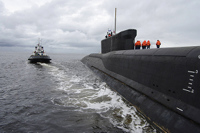Russia's gigantic Typhoon submarines to be scrapped
The world's largest ballistic missile submarines of Project 941 Akula (Shark), known as Typhoon, will be decommissioned before 2014 and used for scrap metal, a source at Russia's Defense Ministry told the Izvestia newspaper.

All three operating submarines of the project - Arkhangelsk, Severstal and Dmitry Donskoi - will thus be destroyed. The Dmitry Donskoi cruiser was previously used as the base for launching Russia's new Bulava ballistic missile. The decommissioning of the missiles will cost the Russian budget hundreds of millions of rubles, experts said.
Defense officials said that it became impossible to use the above-mentioned submarines for intended purposes because of the Strategic Arms Reduction Treaty (START-3), which Russia had signed with the United States. Specialists of Sevmash Enterprise (the maker of the subs) said that it could be possible to redesign the submarines to use them as undersea gas tankers or all-season marine freight vessels. However, defense ministry officials said that the cost for this work would be unreasonably high.
It was Borei class submarines that ruined the career of the Typhoons, defense officials said. Borei is a new class of submarines, which Sevmash Enterprise currently builds. The new subs will be armed with Bulava missiles.
The tests of Borei submarines ended successfully, which made the maintenance of bulky and more expensive typhoon submarines pointless. The crew of the Borei sub is 1.5 times smaller than that of the Typhoon. Maintenance costs also differ in Borei's favor. To crown it all, it is much more difficult to detect Borei submarines in the water, officials said.
Officials representing the Defense Ministry also said that any work to redesign the submarines would cost tens of billions of rubles. Therefore, it would be more reasonable to spend this money on building new vessels, they said.
Specialists of Sevmash Enterprise said, though, that the Typhoon subs could be transformed into undersea tankers and freighters to transport liquefied gas, oil and cargoes for polar ports. "This reconstruction may not cost that much," representatives of the enterprise said.
Alexander Konovalov, the President of the Institute of Strategic Estimations, shares a different point of view. According to him, the era of Typhoons is gone for good.
"This is a gigantic thing. It is the largest sub in the world, and it is very expensive in its exploitation. Moreover, there are no missiles for these subs," he said.
The fate of gigantic submarines was determined by the START-3 Treaty, which was signed by Russian and US presidents in the spring of 2010. The treaty restricted the strategic arsenals of the two countries to 1,550 nuclear warheads.
Russia's Project 955 Borei and 667BDRM Dolphin submarines may carry over 1,100 nuclear blocks. The remaining part can be used by long-distance aviation and Special Purpose Missile Troops.
One Typhoon class submarine is capable of carrying of only 120-200 nuclear warheads.
Russia's Defense Ministry has already decommissioned three of the six Akula submarines before in accordance with the START-2 Treaty. Russia decided that it was too expensive to maintain the battle capacity of those submarines. Each cruiser required nearly 300 million rubles a year.
The decommissioning process took place as follows. Spent nuclear fuel was unloaded from the reactors. The equipment was dismantled afterwards. The subs were then transferred to the dry dock. In the dock, specialists cut out the reactor compartments from the subs. The compartments were subsequently transferred to long-storage facilities in the Murmansk region.
The utilization of one cruiser cost $10 million. Two million dollars of the amount were assigned from the Russian budget. The remaining funds were provided by the United States and Canada.
The Project 941 or Akula, ("Shark") class submarine (NATO reporting name: Typhoon) is a type of nuclear-powered ballistic missile submarine deployed by the Soviet Navy in the 1980s. With a submerged displacement of 48,000 tons,the Typhoons are the largest class of submarine ever built,large enough to accommodate decent living facilities for the crew when submerged for months on end.The source of the NATO reporting name remains unclear, although it is often claimed to be related to the use of the word "Typhoon" by Leonid Brezhnev in a 1974 speech while describing a new type of nuclear ballistic missile submarine. Soviet doctrine for these vessels was to have them launch SLBMs while submerged under the arctic ice, avoiding the traversal of the GIUK gap to remain safe from the enemy attack submarines and anti-submarine forces. Technically Typhoons were also able to successfully deploy their long-range nuclear missiles while moored at their dock.
The Borei class is a class of nuclear-powered ballistic missile submarine produced and operated by the Russian Navy. The class is intended to replace the Delta III, Delta IV and Typhoon classes now in Russian Navy service. The class is named after Boreas, the North wind. The sub is 160 meters long; its maximum displacement measures 24,000 tons. The submergence depth - up to 400 meters. The crew - 107 people.
Sevmash currently builds three Borei class submarines: Alexander Nevsky, Vladimir Monomakh and Saint Nikolai. The construction of the first submarine - Yuri Dolgoruky - began on November 2, 1996. The sub was launched on February 12, 2008.
Alexander Nevsky was launched on December 6, 2010. The sub is to be passed into service in 2012.
Subscribe to Pravda.Ru Telegram channel, Facebook, RSS!


